Management Accounting Report: Capital Budgeting and Pricing Approaches
VerifiedAdded on 2019/12/03
|13
|2797
|165
Report
AI Summary
This report provides an in-depth analysis of management accounting principles, focusing on the case study of KingtonTech Ltd. It begins with an executive summary outlining the core concepts of management accounting and investment appraisal. The main body of the report calculates Net Present Value (NPV) and Internal Rate of Return (IRR) to evaluate investment proposals. The report also compares two approaches to capital budgeting decisions using discounted cash flow techniques, and discusses the limitations of various investment appraisal methods, including Payback Period and Average Rate of Return, alongside the importance of non-monetary aspects in decision-making. Furthermore, it explores the complementary nature of different investment appraisal methods and analyzes various pricing approaches, recommending the most suitable strategy for the company. The report concludes that NPV is the best method for long-term investment analysis and recommends a cost-plus pricing approach for KingtonTech Ltd., supported by relevant references.

MANAGEMENT
ACCOUNTING
ACCOUNTING
Paraphrase This Document
Need a fresh take? Get an instant paraphrase of this document with our AI Paraphraser
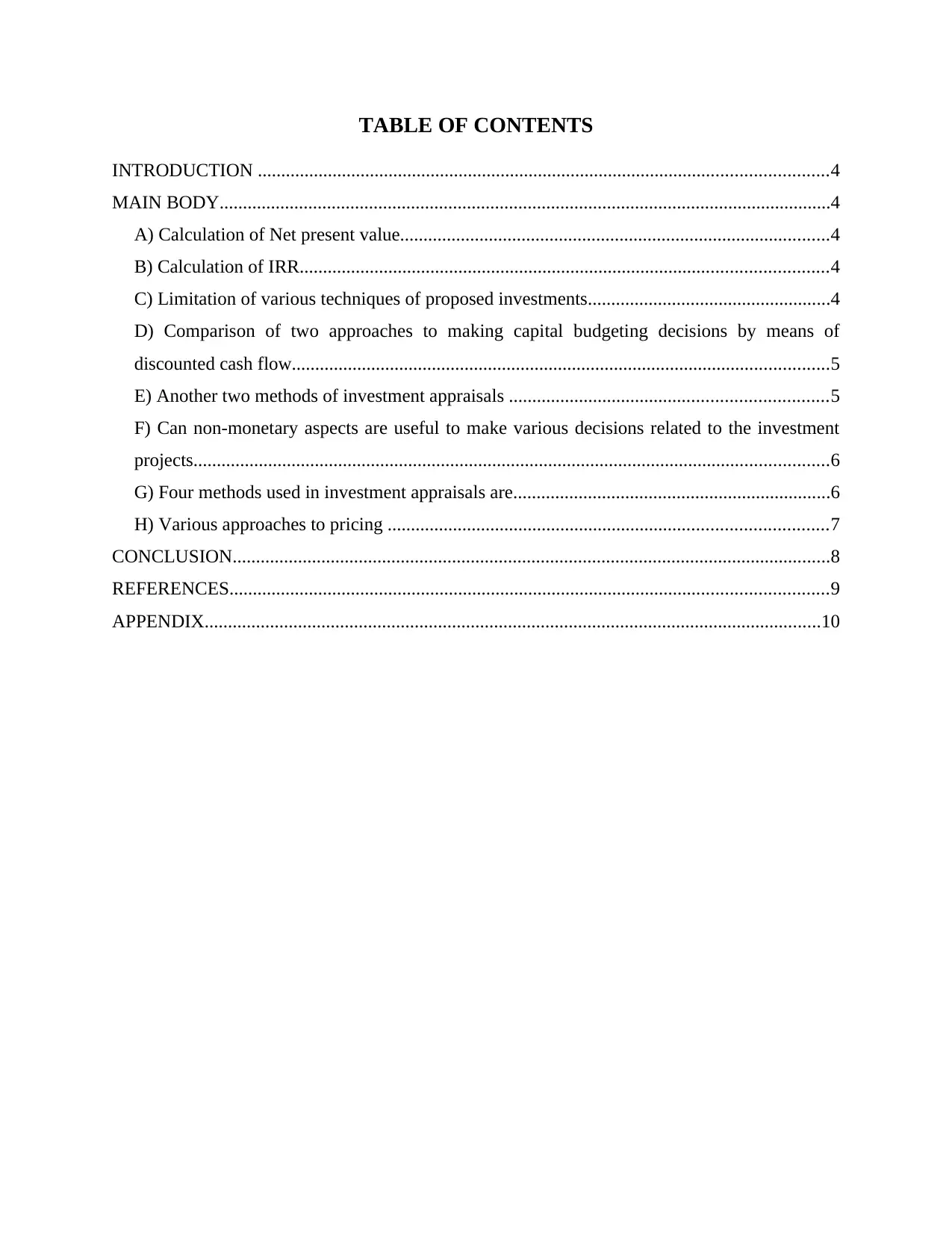
TABLE OF CONTENTS
INTRODUCTION ..........................................................................................................................4
MAIN BODY...................................................................................................................................4
A) Calculation of Net present value............................................................................................4
B) Calculation of IRR.................................................................................................................4
C) Limitation of various techniques of proposed investments....................................................4
D) Comparison of two approaches to making capital budgeting decisions by means of
discounted cash flow...................................................................................................................5
E) Another two methods of investment appraisals ....................................................................5
F) Can non-monetary aspects are useful to make various decisions related to the investment
projects........................................................................................................................................6
G) Four methods used in investment appraisals are....................................................................6
H) Various approaches to pricing ..............................................................................................7
CONCLUSION................................................................................................................................8
REFERENCES................................................................................................................................9
APPENDIX....................................................................................................................................10
INTRODUCTION ..........................................................................................................................4
MAIN BODY...................................................................................................................................4
A) Calculation of Net present value............................................................................................4
B) Calculation of IRR.................................................................................................................4
C) Limitation of various techniques of proposed investments....................................................4
D) Comparison of two approaches to making capital budgeting decisions by means of
discounted cash flow...................................................................................................................5
E) Another two methods of investment appraisals ....................................................................5
F) Can non-monetary aspects are useful to make various decisions related to the investment
projects........................................................................................................................................6
G) Four methods used in investment appraisals are....................................................................6
H) Various approaches to pricing ..............................................................................................7
CONCLUSION................................................................................................................................8
REFERENCES................................................................................................................................9
APPENDIX....................................................................................................................................10
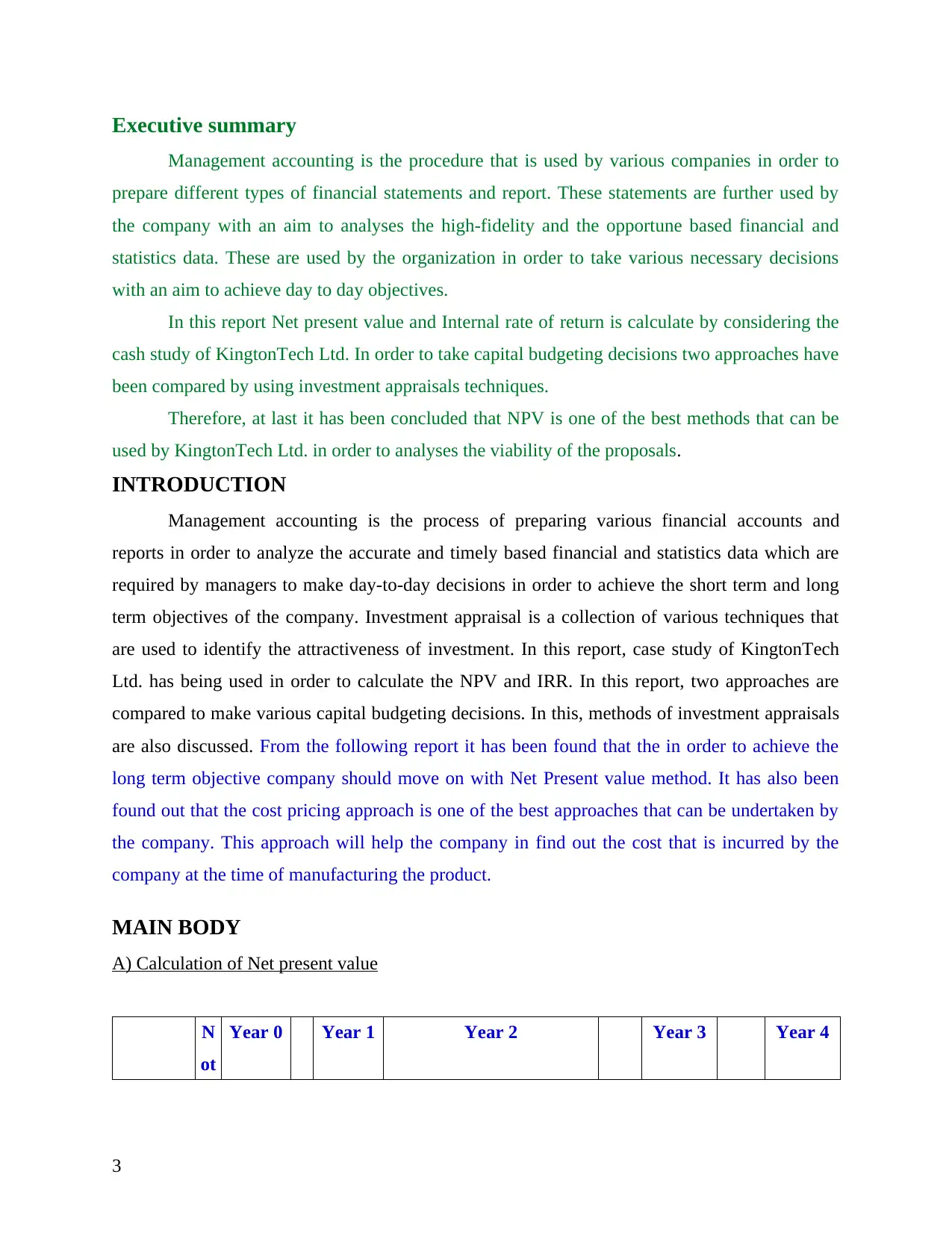
Executive summary
Management accounting is the procedure that is used by various companies in order to
prepare different types of financial statements and report. These statements are further used by
the company with an aim to analyses the high-fidelity and the opportune based financial and
statistics data. These are used by the organization in order to take various necessary decisions
with an aim to achieve day to day objectives.
In this report Net present value and Internal rate of return is calculate by considering the
cash study of KingtonTech Ltd. In order to take capital budgeting decisions two approaches have
been compared by using investment appraisals techniques.
Therefore, at last it has been concluded that NPV is one of the best methods that can be
used by KingtonTech Ltd. in order to analyses the viability of the proposals.
INTRODUCTION
Management accounting is the process of preparing various financial accounts and
reports in order to analyze the accurate and timely based financial and statistics data which are
required by managers to make day-to-day decisions in order to achieve the short term and long
term objectives of the company. Investment appraisal is a collection of various techniques that
are used to identify the attractiveness of investment. In this report, case study of KingtonTech
Ltd. has being used in order to calculate the NPV and IRR. In this report, two approaches are
compared to make various capital budgeting decisions. In this, methods of investment appraisals
are also discussed. From the following report it has been found that the in order to achieve the
long term objective company should move on with Net Present value method. It has also been
found out that the cost pricing approach is one of the best approaches that can be undertaken by
the company. This approach will help the company in find out the cost that is incurred by the
company at the time of manufacturing the product.
MAIN BODY
A) Calculation of Net present value
N
ot
Year 0 Year 1 Year 2 Year 3 Year 4
3
Management accounting is the procedure that is used by various companies in order to
prepare different types of financial statements and report. These statements are further used by
the company with an aim to analyses the high-fidelity and the opportune based financial and
statistics data. These are used by the organization in order to take various necessary decisions
with an aim to achieve day to day objectives.
In this report Net present value and Internal rate of return is calculate by considering the
cash study of KingtonTech Ltd. In order to take capital budgeting decisions two approaches have
been compared by using investment appraisals techniques.
Therefore, at last it has been concluded that NPV is one of the best methods that can be
used by KingtonTech Ltd. in order to analyses the viability of the proposals.
INTRODUCTION
Management accounting is the process of preparing various financial accounts and
reports in order to analyze the accurate and timely based financial and statistics data which are
required by managers to make day-to-day decisions in order to achieve the short term and long
term objectives of the company. Investment appraisal is a collection of various techniques that
are used to identify the attractiveness of investment. In this report, case study of KingtonTech
Ltd. has being used in order to calculate the NPV and IRR. In this report, two approaches are
compared to make various capital budgeting decisions. In this, methods of investment appraisals
are also discussed. From the following report it has been found that the in order to achieve the
long term objective company should move on with Net Present value method. It has also been
found out that the cost pricing approach is one of the best approaches that can be undertaken by
the company. This approach will help the company in find out the cost that is incurred by the
company at the time of manufacturing the product.
MAIN BODY
A) Calculation of Net present value
N
ot
Year 0 Year 1 Year 2 Year 3 Year 4
3
⊘ This is a preview!⊘
Do you want full access?
Subscribe today to unlock all pages.

Trusted by 1+ million students worldwide

es
£ £ £ £
Sales
Revenue 1
7,28,00
0 11,46,390
16,87,50
0 8,42,400
Costs:
Variable
cost 2
(4,41,0
00) (7,01,190)
(10,41,
750)
(5,24,88
0)
Total
Contribut
ion 3
2,87,00
0 4,45,200 6,45,750 3,17,520
Capital
allowanc
es
(Deprecia
tion) 4
(2,50,0
00) (2,50,000)
(2,50,0
00)
(2,50,00
0)
Taxable
profit 5 37,000 1,95,200 3,95,750 67,520
Taxation
(30% per
year) 6
(11,10
0) (58,560)
(1,18,7
25)
(20,256
)
After tax
profit 7 25,900 1,36,640
2,77,02
5 47,264
Capital
allowanc
es
(Deprecia
tion) 8
2,50,00
0 2,50,000 2,50,000 2,50,000
After-tax 9 2,75,90 3,86,640 5,27,02 2,97,26
4
£ £ £ £
Sales
Revenue 1
7,28,00
0 11,46,390
16,87,50
0 8,42,400
Costs:
Variable
cost 2
(4,41,0
00) (7,01,190)
(10,41,
750)
(5,24,88
0)
Total
Contribut
ion 3
2,87,00
0 4,45,200 6,45,750 3,17,520
Capital
allowanc
es
(Deprecia
tion) 4
(2,50,0
00) (2,50,000)
(2,50,0
00)
(2,50,00
0)
Taxable
profit 5 37,000 1,95,200 3,95,750 67,520
Taxation
(30% per
year) 6
(11,10
0) (58,560)
(1,18,7
25)
(20,256
)
After tax
profit 7 25,900 1,36,640
2,77,02
5 47,264
Capital
allowanc
es
(Deprecia
tion) 8
2,50,00
0 2,50,000 2,50,000 2,50,000
After-tax 9 2,75,90 3,86,640 5,27,02 2,97,26
4
Paraphrase This Document
Need a fresh take? Get an instant paraphrase of this document with our AI Paraphraser
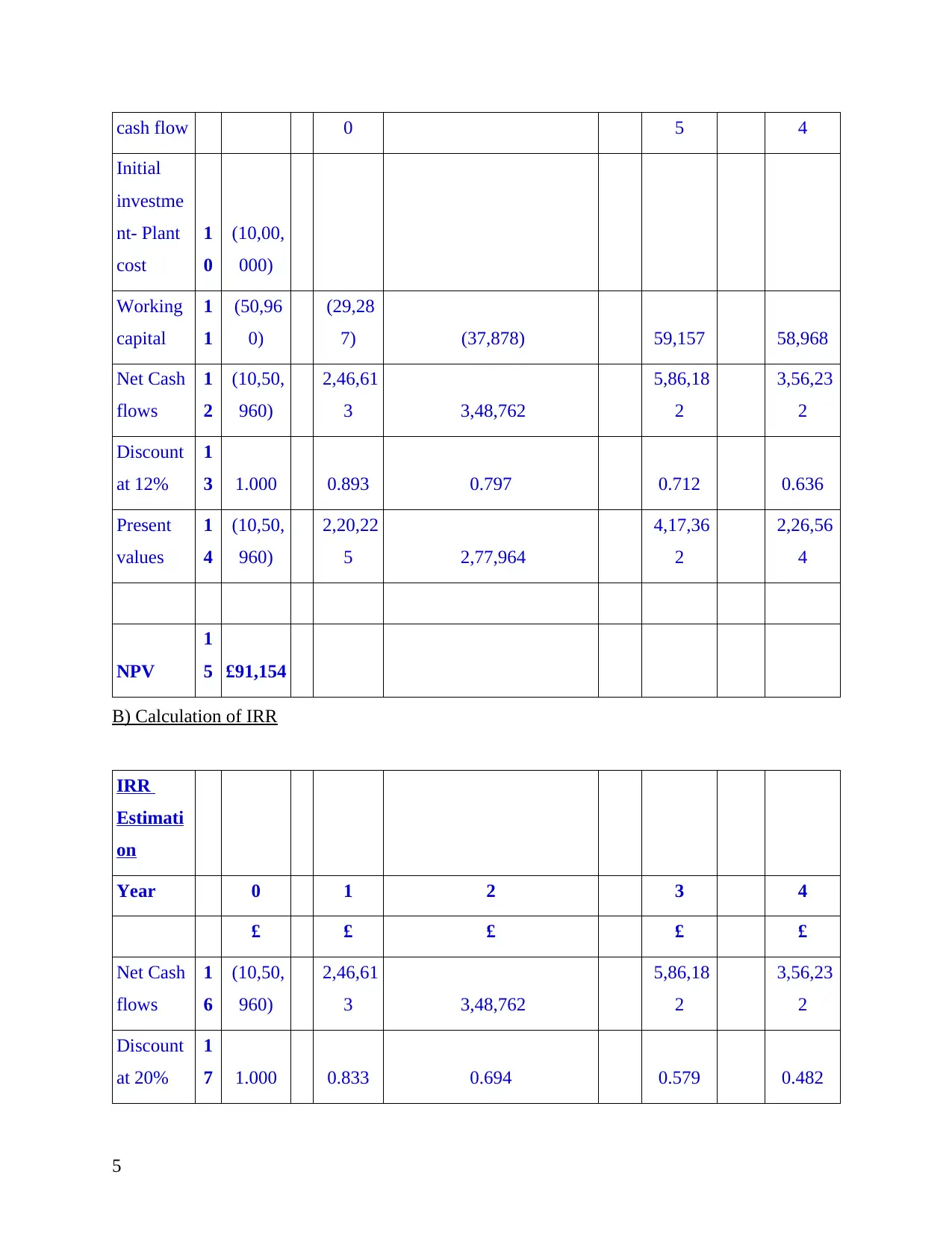
cash flow 0 5 4
Initial
investme
nt- Plant
cost
1
0
(10,00,
000)
Working
capital
1
1
(50,96
0)
(29,28
7) (37,878) 59,157 58,968
Net Cash
flows
1
2
(10,50,
960)
2,46,61
3 3,48,762
5,86,18
2
3,56,23
2
Discount
at 12%
1
3 1.000 0.893 0.797 0.712 0.636
Present
values
1
4
(10,50,
960)
2,20,22
5 2,77,964
4,17,36
2
2,26,56
4
NPV
1
5 £91,154
B) Calculation of IRR
IRR
Estimati
on
Year 0 1 2 3 4
£ £ £ £ £
Net Cash
flows
1
6
(10,50,
960)
2,46,61
3 3,48,762
5,86,18
2
3,56,23
2
Discount
at 20%
1
7 1.000 0.833 0.694 0.579 0.482
5
Initial
investme
nt- Plant
cost
1
0
(10,00,
000)
Working
capital
1
1
(50,96
0)
(29,28
7) (37,878) 59,157 58,968
Net Cash
flows
1
2
(10,50,
960)
2,46,61
3 3,48,762
5,86,18
2
3,56,23
2
Discount
at 12%
1
3 1.000 0.893 0.797 0.712 0.636
Present
values
1
4
(10,50,
960)
2,20,22
5 2,77,964
4,17,36
2
2,26,56
4
NPV
1
5 £91,154
B) Calculation of IRR
IRR
Estimati
on
Year 0 1 2 3 4
£ £ £ £ £
Net Cash
flows
1
6
(10,50,
960)
2,46,61
3 3,48,762
5,86,18
2
3,56,23
2
Discount
at 20%
1
7 1.000 0.833 0.694 0.579 0.482
5
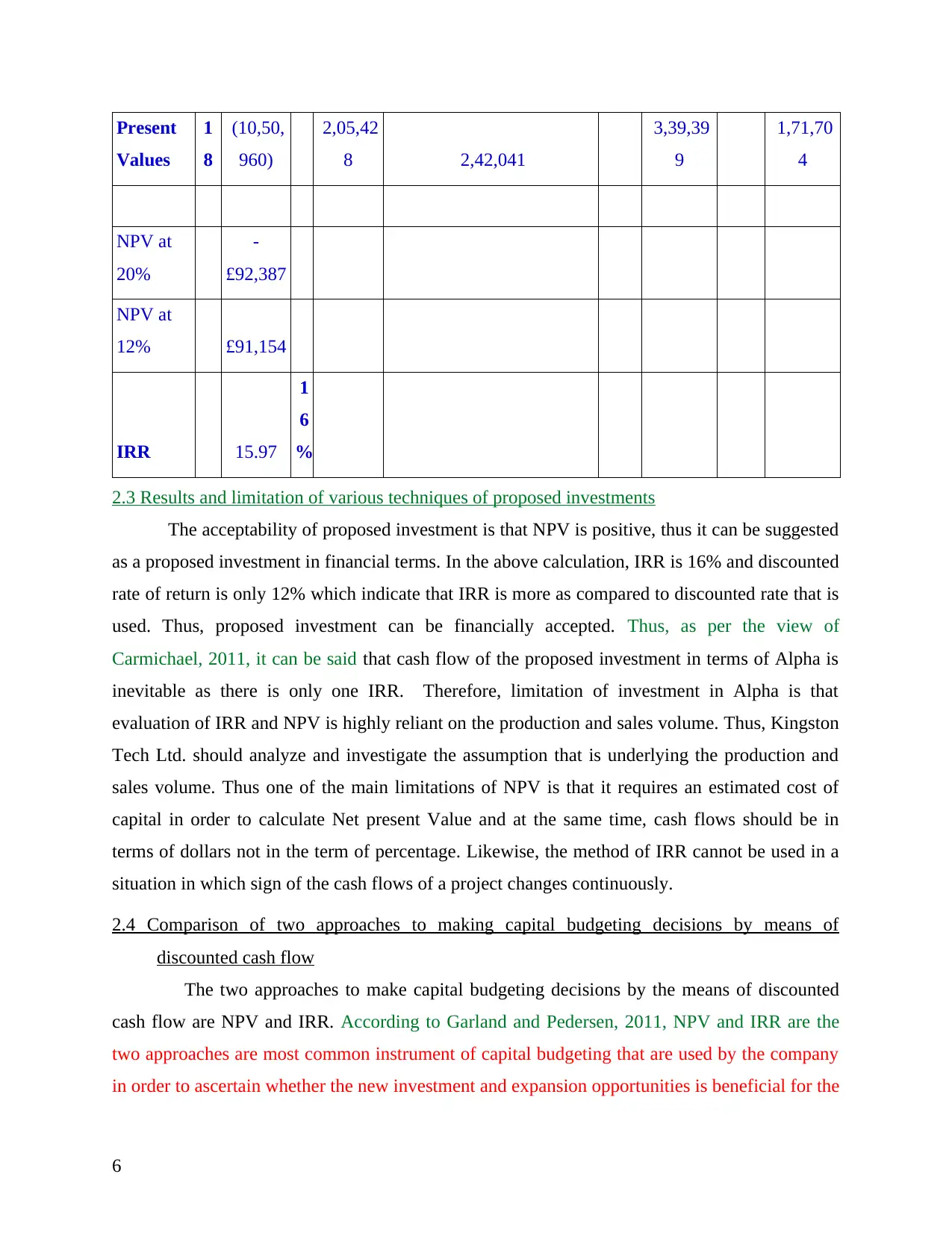
Present
Values
1
8
(10,50,
960)
2,05,42
8 2,42,041
3,39,39
9
1,71,70
4
NPV at
20%
-
£92,387
NPV at
12% £91,154
IRR 15.97
1
6
%
2.3 Results and limitation of various techniques of proposed investments
The acceptability of proposed investment is that NPV is positive, thus it can be suggested
as a proposed investment in financial terms. In the above calculation, IRR is 16% and discounted
rate of return is only 12% which indicate that IRR is more as compared to discounted rate that is
used. Thus, proposed investment can be financially accepted. Thus, as per the view of
Carmichael, 2011, it can be said that cash flow of the proposed investment in terms of Alpha is
inevitable as there is only one IRR. Therefore, limitation of investment in Alpha is that
evaluation of IRR and NPV is highly reliant on the production and sales volume. Thus, Kingston
Tech Ltd. should analyze and investigate the assumption that is underlying the production and
sales volume. Thus one of the main limitations of NPV is that it requires an estimated cost of
capital in order to calculate Net present Value and at the same time, cash flows should be in
terms of dollars not in the term of percentage. Likewise, the method of IRR cannot be used in a
situation in which sign of the cash flows of a project changes continuously.
2.4 Comparison of two approaches to making capital budgeting decisions by means of
discounted cash flow
The two approaches to make capital budgeting decisions by the means of discounted
cash flow are NPV and IRR. According to Garland and Pedersen, 2011, NPV and IRR are the
two approaches are most common instrument of capital budgeting that are used by the company
in order to ascertain whether the new investment and expansion opportunities is beneficial for the
6
Values
1
8
(10,50,
960)
2,05,42
8 2,42,041
3,39,39
9
1,71,70
4
NPV at
20%
-
£92,387
NPV at
12% £91,154
IRR 15.97
1
6
%
2.3 Results and limitation of various techniques of proposed investments
The acceptability of proposed investment is that NPV is positive, thus it can be suggested
as a proposed investment in financial terms. In the above calculation, IRR is 16% and discounted
rate of return is only 12% which indicate that IRR is more as compared to discounted rate that is
used. Thus, proposed investment can be financially accepted. Thus, as per the view of
Carmichael, 2011, it can be said that cash flow of the proposed investment in terms of Alpha is
inevitable as there is only one IRR. Therefore, limitation of investment in Alpha is that
evaluation of IRR and NPV is highly reliant on the production and sales volume. Thus, Kingston
Tech Ltd. should analyze and investigate the assumption that is underlying the production and
sales volume. Thus one of the main limitations of NPV is that it requires an estimated cost of
capital in order to calculate Net present Value and at the same time, cash flows should be in
terms of dollars not in the term of percentage. Likewise, the method of IRR cannot be used in a
situation in which sign of the cash flows of a project changes continuously.
2.4 Comparison of two approaches to making capital budgeting decisions by means of
discounted cash flow
The two approaches to make capital budgeting decisions by the means of discounted
cash flow are NPV and IRR. According to Garland and Pedersen, 2011, NPV and IRR are the
two approaches are most common instrument of capital budgeting that are used by the company
in order to ascertain whether the new investment and expansion opportunities is beneficial for the
6
⊘ This is a preview!⊘
Do you want full access?
Subscribe today to unlock all pages.

Trusted by 1+ million students worldwide
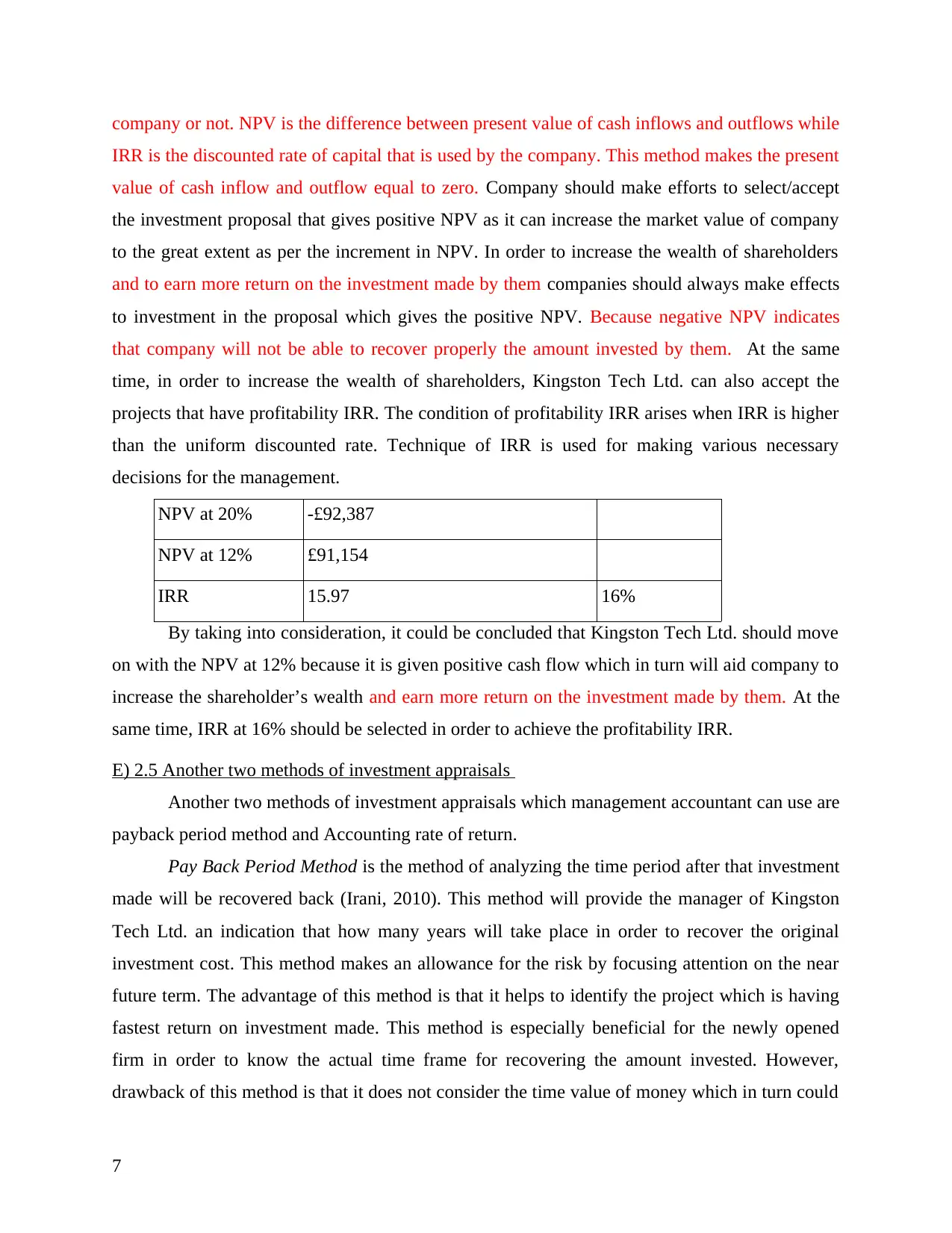
company or not. NPV is the difference between present value of cash inflows and outflows while
IRR is the discounted rate of capital that is used by the company. This method makes the present
value of cash inflow and outflow equal to zero. Company should make efforts to select/accept
the investment proposal that gives positive NPV as it can increase the market value of company
to the great extent as per the increment in NPV. In order to increase the wealth of shareholders
and to earn more return on the investment made by them companies should always make effects
to investment in the proposal which gives the positive NPV. Because negative NPV indicates
that company will not be able to recover properly the amount invested by them. At the same
time, in order to increase the wealth of shareholders, Kingston Tech Ltd. can also accept the
projects that have profitability IRR. The condition of profitability IRR arises when IRR is higher
than the uniform discounted rate. Technique of IRR is used for making various necessary
decisions for the management.
NPV at 20% -£92,387
NPV at 12% £91,154
IRR 15.97 16%
By taking into consideration, it could be concluded that Kingston Tech Ltd. should move
on with the NPV at 12% because it is given positive cash flow which in turn will aid company to
increase the shareholder’s wealth and earn more return on the investment made by them. At the
same time, IRR at 16% should be selected in order to achieve the profitability IRR.
E) 2.5 Another two methods of investment appraisals
Another two methods of investment appraisals which management accountant can use are
payback period method and Accounting rate of return.
Pay Back Period Method is the method of analyzing the time period after that investment
made will be recovered back (Irani, 2010). This method will provide the manager of Kingston
Tech Ltd. an indication that how many years will take place in order to recover the original
investment cost. This method makes an allowance for the risk by focusing attention on the near
future term. The advantage of this method is that it helps to identify the project which is having
fastest return on investment made. This method is especially beneficial for the newly opened
firm in order to know the actual time frame for recovering the amount invested. However,
drawback of this method is that it does not consider the time value of money which in turn could
7
IRR is the discounted rate of capital that is used by the company. This method makes the present
value of cash inflow and outflow equal to zero. Company should make efforts to select/accept
the investment proposal that gives positive NPV as it can increase the market value of company
to the great extent as per the increment in NPV. In order to increase the wealth of shareholders
and to earn more return on the investment made by them companies should always make effects
to investment in the proposal which gives the positive NPV. Because negative NPV indicates
that company will not be able to recover properly the amount invested by them. At the same
time, in order to increase the wealth of shareholders, Kingston Tech Ltd. can also accept the
projects that have profitability IRR. The condition of profitability IRR arises when IRR is higher
than the uniform discounted rate. Technique of IRR is used for making various necessary
decisions for the management.
NPV at 20% -£92,387
NPV at 12% £91,154
IRR 15.97 16%
By taking into consideration, it could be concluded that Kingston Tech Ltd. should move
on with the NPV at 12% because it is given positive cash flow which in turn will aid company to
increase the shareholder’s wealth and earn more return on the investment made by them. At the
same time, IRR at 16% should be selected in order to achieve the profitability IRR.
E) 2.5 Another two methods of investment appraisals
Another two methods of investment appraisals which management accountant can use are
payback period method and Accounting rate of return.
Pay Back Period Method is the method of analyzing the time period after that investment
made will be recovered back (Irani, 2010). This method will provide the manager of Kingston
Tech Ltd. an indication that how many years will take place in order to recover the original
investment cost. This method makes an allowance for the risk by focusing attention on the near
future term. The advantage of this method is that it helps to identify the project which is having
fastest return on investment made. This method is especially beneficial for the newly opened
firm in order to know the actual time frame for recovering the amount invested. However,
drawback of this method is that it does not consider the time value of money which in turn could
7
Paraphrase This Document
Need a fresh take? Get an instant paraphrase of this document with our AI Paraphraser
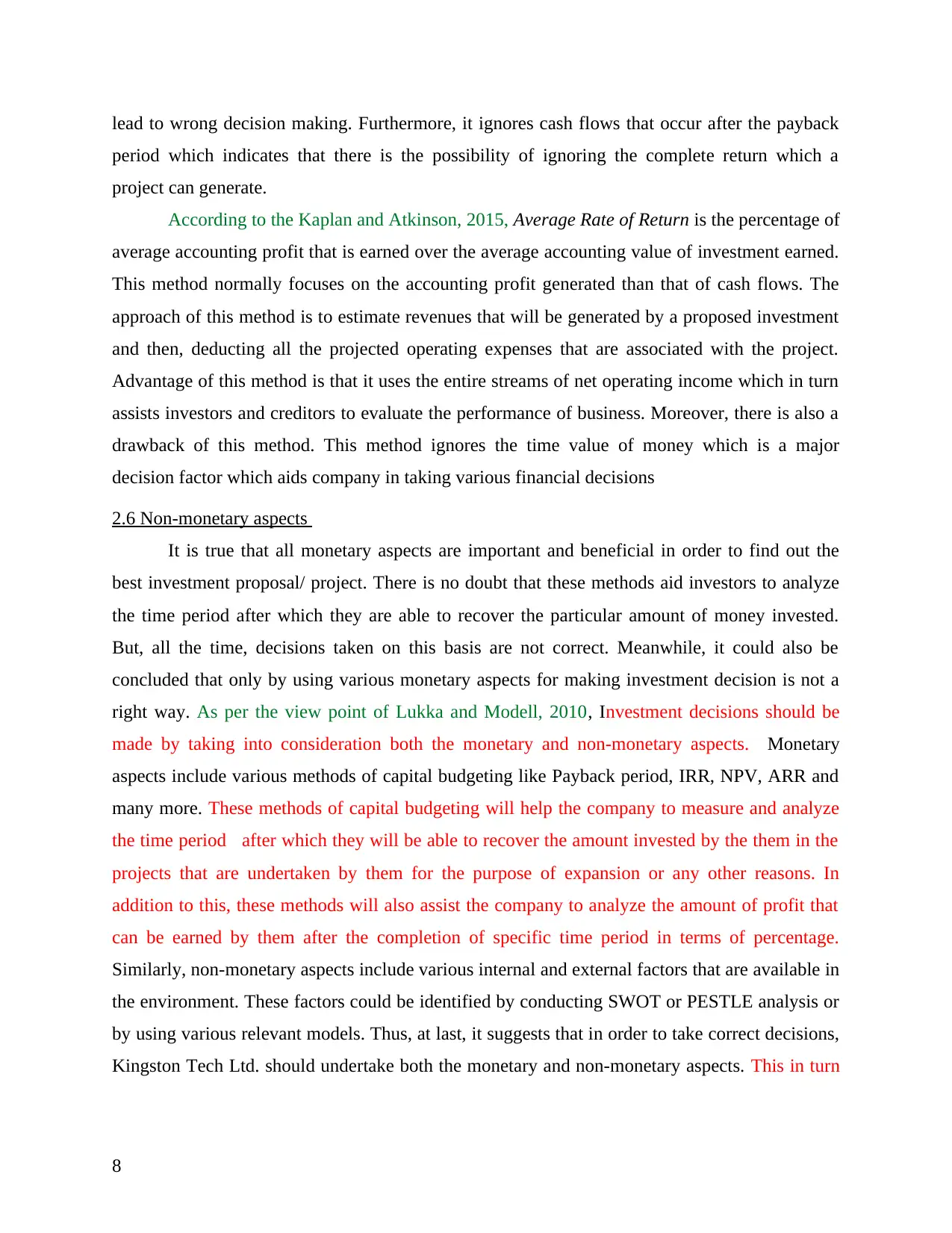
lead to wrong decision making. Furthermore, it ignores cash flows that occur after the payback
period which indicates that there is the possibility of ignoring the complete return which a
project can generate.
According to the Kaplan and Atkinson, 2015, Average Rate of Return is the percentage of
average accounting profit that is earned over the average accounting value of investment earned.
This method normally focuses on the accounting profit generated than that of cash flows. The
approach of this method is to estimate revenues that will be generated by a proposed investment
and then, deducting all the projected operating expenses that are associated with the project.
Advantage of this method is that it uses the entire streams of net operating income which in turn
assists investors and creditors to evaluate the performance of business. Moreover, there is also a
drawback of this method. This method ignores the time value of money which is a major
decision factor which aids company in taking various financial decisions
2.6 Non-monetary aspects
It is true that all monetary aspects are important and beneficial in order to find out the
best investment proposal/ project. There is no doubt that these methods aid investors to analyze
the time period after which they are able to recover the particular amount of money invested.
But, all the time, decisions taken on this basis are not correct. Meanwhile, it could also be
concluded that only by using various monetary aspects for making investment decision is not a
right way. As per the view point of Lukka and Modell, 2010, Investment decisions should be
made by taking into consideration both the monetary and non-monetary aspects. Monetary
aspects include various methods of capital budgeting like Payback period, IRR, NPV, ARR and
many more. These methods of capital budgeting will help the company to measure and analyze
the time period after which they will be able to recover the amount invested by the them in the
projects that are undertaken by them for the purpose of expansion or any other reasons. In
addition to this, these methods will also assist the company to analyze the amount of profit that
can be earned by them after the completion of specific time period in terms of percentage.
Similarly, non-monetary aspects include various internal and external factors that are available in
the environment. These factors could be identified by conducting SWOT or PESTLE analysis or
by using various relevant models. Thus, at last, it suggests that in order to take correct decisions,
Kingston Tech Ltd. should undertake both the monetary and non-monetary aspects. This in turn
8
period which indicates that there is the possibility of ignoring the complete return which a
project can generate.
According to the Kaplan and Atkinson, 2015, Average Rate of Return is the percentage of
average accounting profit that is earned over the average accounting value of investment earned.
This method normally focuses on the accounting profit generated than that of cash flows. The
approach of this method is to estimate revenues that will be generated by a proposed investment
and then, deducting all the projected operating expenses that are associated with the project.
Advantage of this method is that it uses the entire streams of net operating income which in turn
assists investors and creditors to evaluate the performance of business. Moreover, there is also a
drawback of this method. This method ignores the time value of money which is a major
decision factor which aids company in taking various financial decisions
2.6 Non-monetary aspects
It is true that all monetary aspects are important and beneficial in order to find out the
best investment proposal/ project. There is no doubt that these methods aid investors to analyze
the time period after which they are able to recover the particular amount of money invested.
But, all the time, decisions taken on this basis are not correct. Meanwhile, it could also be
concluded that only by using various monetary aspects for making investment decision is not a
right way. As per the view point of Lukka and Modell, 2010, Investment decisions should be
made by taking into consideration both the monetary and non-monetary aspects. Monetary
aspects include various methods of capital budgeting like Payback period, IRR, NPV, ARR and
many more. These methods of capital budgeting will help the company to measure and analyze
the time period after which they will be able to recover the amount invested by the them in the
projects that are undertaken by them for the purpose of expansion or any other reasons. In
addition to this, these methods will also assist the company to analyze the amount of profit that
can be earned by them after the completion of specific time period in terms of percentage.
Similarly, non-monetary aspects include various internal and external factors that are available in
the environment. These factors could be identified by conducting SWOT or PESTLE analysis or
by using various relevant models. Thus, at last, it suggests that in order to take correct decisions,
Kingston Tech Ltd. should undertake both the monetary and non-monetary aspects. This in turn
8
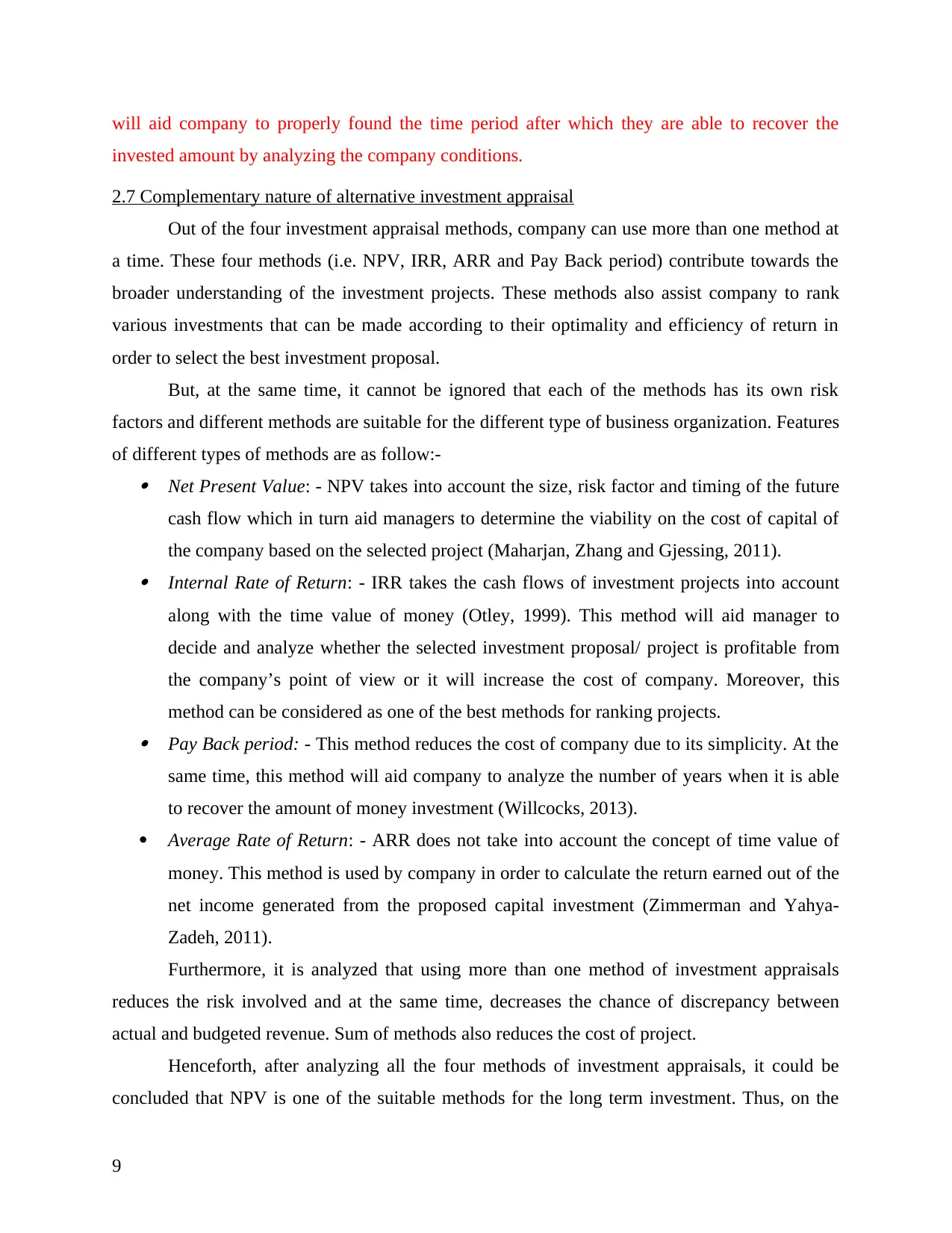
will aid company to properly found the time period after which they are able to recover the
invested amount by analyzing the company conditions.
2.7 Complementary nature of alternative investment appraisal
Out of the four investment appraisal methods, company can use more than one method at
a time. These four methods (i.e. NPV, IRR, ARR and Pay Back period) contribute towards the
broader understanding of the investment projects. These methods also assist company to rank
various investments that can be made according to their optimality and efficiency of return in
order to select the best investment proposal.
But, at the same time, it cannot be ignored that each of the methods has its own risk
factors and different methods are suitable for the different type of business organization. Features
of different types of methods are as follow:- Net Present Value: - NPV takes into account the size, risk factor and timing of the future
cash flow which in turn aid managers to determine the viability on the cost of capital of
the company based on the selected project (Maharjan, Zhang and Gjessing, 2011). Internal Rate of Return: - IRR takes the cash flows of investment projects into account
along with the time value of money (Otley, 1999). This method will aid manager to
decide and analyze whether the selected investment proposal/ project is profitable from
the company’s point of view or it will increase the cost of company. Moreover, this
method can be considered as one of the best methods for ranking projects. Pay Back period: - This method reduces the cost of company due to its simplicity. At the
same time, this method will aid company to analyze the number of years when it is able
to recover the amount of money investment (Willcocks, 2013).
Average Rate of Return: - ARR does not take into account the concept of time value of
money. This method is used by company in order to calculate the return earned out of the
net income generated from the proposed capital investment (Zimmerman and Yahya-
Zadeh, 2011).
Furthermore, it is analyzed that using more than one method of investment appraisals
reduces the risk involved and at the same time, decreases the chance of discrepancy between
actual and budgeted revenue. Sum of methods also reduces the cost of project.
Henceforth, after analyzing all the four methods of investment appraisals, it could be
concluded that NPV is one of the suitable methods for the long term investment. Thus, on the
9
invested amount by analyzing the company conditions.
2.7 Complementary nature of alternative investment appraisal
Out of the four investment appraisal methods, company can use more than one method at
a time. These four methods (i.e. NPV, IRR, ARR and Pay Back period) contribute towards the
broader understanding of the investment projects. These methods also assist company to rank
various investments that can be made according to their optimality and efficiency of return in
order to select the best investment proposal.
But, at the same time, it cannot be ignored that each of the methods has its own risk
factors and different methods are suitable for the different type of business organization. Features
of different types of methods are as follow:- Net Present Value: - NPV takes into account the size, risk factor and timing of the future
cash flow which in turn aid managers to determine the viability on the cost of capital of
the company based on the selected project (Maharjan, Zhang and Gjessing, 2011). Internal Rate of Return: - IRR takes the cash flows of investment projects into account
along with the time value of money (Otley, 1999). This method will aid manager to
decide and analyze whether the selected investment proposal/ project is profitable from
the company’s point of view or it will increase the cost of company. Moreover, this
method can be considered as one of the best methods for ranking projects. Pay Back period: - This method reduces the cost of company due to its simplicity. At the
same time, this method will aid company to analyze the number of years when it is able
to recover the amount of money investment (Willcocks, 2013).
Average Rate of Return: - ARR does not take into account the concept of time value of
money. This method is used by company in order to calculate the return earned out of the
net income generated from the proposed capital investment (Zimmerman and Yahya-
Zadeh, 2011).
Furthermore, it is analyzed that using more than one method of investment appraisals
reduces the risk involved and at the same time, decreases the chance of discrepancy between
actual and budgeted revenue. Sum of methods also reduces the cost of project.
Henceforth, after analyzing all the four methods of investment appraisals, it could be
concluded that NPV is one of the suitable methods for the long term investment. Thus, on the
9
⊘ This is a preview!⊘
Do you want full access?
Subscribe today to unlock all pages.

Trusted by 1+ million students worldwide
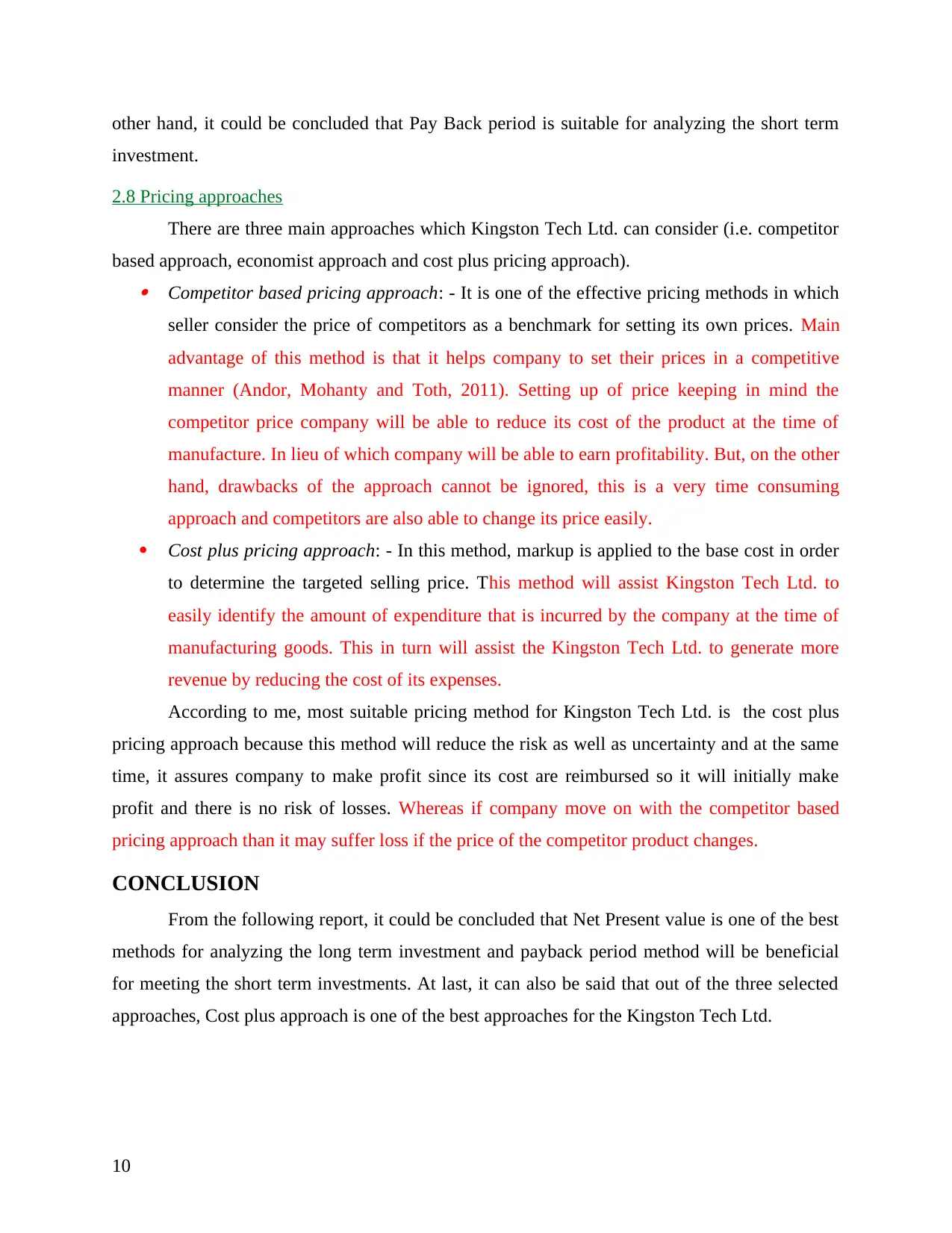
other hand, it could be concluded that Pay Back period is suitable for analyzing the short term
investment.
2.8 Pricing approaches
There are three main approaches which Kingston Tech Ltd. can consider (i.e. competitor
based approach, economist approach and cost plus pricing approach). Competitor based pricing approach: - It is one of the effective pricing methods in which
seller consider the price of competitors as a benchmark for setting its own prices. Main
advantage of this method is that it helps company to set their prices in a competitive
manner (Andor, Mohanty and Toth, 2011). Setting up of price keeping in mind the
competitor price company will be able to reduce its cost of the product at the time of
manufacture. In lieu of which company will be able to earn profitability. But, on the other
hand, drawbacks of the approach cannot be ignored, this is a very time consuming
approach and competitors are also able to change its price easily.
Cost plus pricing approach: - In this method, markup is applied to the base cost in order
to determine the targeted selling price. This method will assist Kingston Tech Ltd. to
easily identify the amount of expenditure that is incurred by the company at the time of
manufacturing goods. This in turn will assist the Kingston Tech Ltd. to generate more
revenue by reducing the cost of its expenses.
According to me, most suitable pricing method for Kingston Tech Ltd. is the cost plus
pricing approach because this method will reduce the risk as well as uncertainty and at the same
time, it assures company to make profit since its cost are reimbursed so it will initially make
profit and there is no risk of losses. Whereas if company move on with the competitor based
pricing approach than it may suffer loss if the price of the competitor product changes.
CONCLUSION
From the following report, it could be concluded that Net Present value is one of the best
methods for analyzing the long term investment and payback period method will be beneficial
for meeting the short term investments. At last, it can also be said that out of the three selected
approaches, Cost plus approach is one of the best approaches for the Kingston Tech Ltd.
10
investment.
2.8 Pricing approaches
There are three main approaches which Kingston Tech Ltd. can consider (i.e. competitor
based approach, economist approach and cost plus pricing approach). Competitor based pricing approach: - It is one of the effective pricing methods in which
seller consider the price of competitors as a benchmark for setting its own prices. Main
advantage of this method is that it helps company to set their prices in a competitive
manner (Andor, Mohanty and Toth, 2011). Setting up of price keeping in mind the
competitor price company will be able to reduce its cost of the product at the time of
manufacture. In lieu of which company will be able to earn profitability. But, on the other
hand, drawbacks of the approach cannot be ignored, this is a very time consuming
approach and competitors are also able to change its price easily.
Cost plus pricing approach: - In this method, markup is applied to the base cost in order
to determine the targeted selling price. This method will assist Kingston Tech Ltd. to
easily identify the amount of expenditure that is incurred by the company at the time of
manufacturing goods. This in turn will assist the Kingston Tech Ltd. to generate more
revenue by reducing the cost of its expenses.
According to me, most suitable pricing method for Kingston Tech Ltd. is the cost plus
pricing approach because this method will reduce the risk as well as uncertainty and at the same
time, it assures company to make profit since its cost are reimbursed so it will initially make
profit and there is no risk of losses. Whereas if company move on with the competitor based
pricing approach than it may suffer loss if the price of the competitor product changes.
CONCLUSION
From the following report, it could be concluded that Net Present value is one of the best
methods for analyzing the long term investment and payback period method will be beneficial
for meeting the short term investments. At last, it can also be said that out of the three selected
approaches, Cost plus approach is one of the best approaches for the Kingston Tech Ltd.
10
Paraphrase This Document
Need a fresh take? Get an instant paraphrase of this document with our AI Paraphraser

Therefore, it can be recommended that company should first analyze the viability of the
proposal than only it selects the best one. Hence, in order to select the best proposal Kingston
Tech Ltd. should move on with Net present value method or internal rate of return method.
11
proposal than only it selects the best one. Hence, in order to select the best proposal Kingston
Tech Ltd. should move on with Net present value method or internal rate of return method.
11
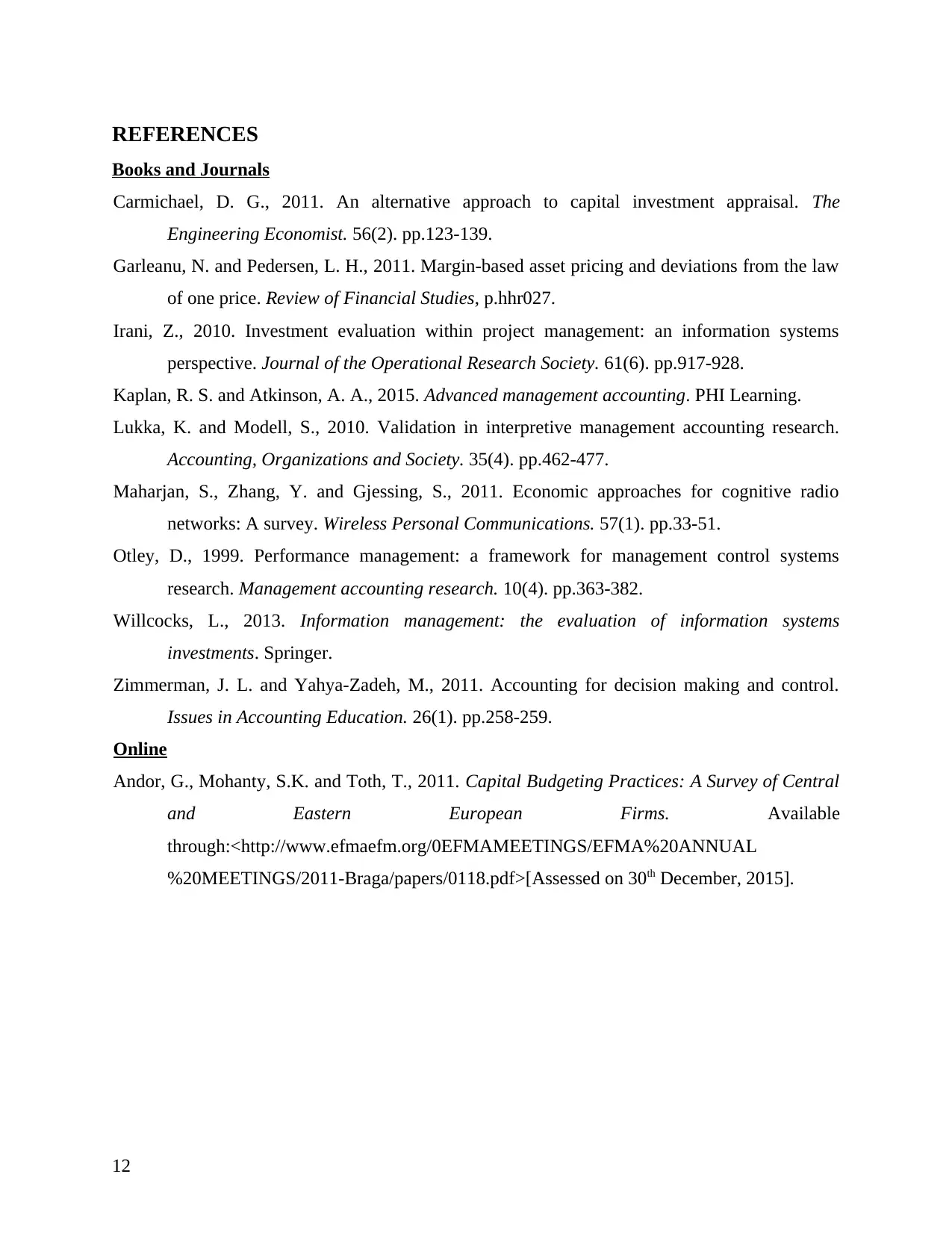
REFERENCES
Books and Journals
Carmichael, D. G., 2011. An alternative approach to capital investment appraisal. The
Engineering Economist. 56(2). pp.123-139.
Garleanu, N. and Pedersen, L. H., 2011. Margin-based asset pricing and deviations from the law
of one price. Review of Financial Studies, p.hhr027.
Irani, Z., 2010. Investment evaluation within project management: an information systems
perspective. Journal of the Operational Research Society. 61(6). pp.917-928.
Kaplan, R. S. and Atkinson, A. A., 2015. Advanced management accounting. PHI Learning.
Lukka, K. and Modell, S., 2010. Validation in interpretive management accounting research.
Accounting, Organizations and Society. 35(4). pp.462-477.
Maharjan, S., Zhang, Y. and Gjessing, S., 2011. Economic approaches for cognitive radio
networks: A survey. Wireless Personal Communications. 57(1). pp.33-51.
Otley, D., 1999. Performance management: a framework for management control systems
research. Management accounting research. 10(4). pp.363-382.
Willcocks, L., 2013. Information management: the evaluation of information systems
investments. Springer.
Zimmerman, J. L. and Yahya-Zadeh, M., 2011. Accounting for decision making and control.
Issues in Accounting Education. 26(1). pp.258-259.
Online
Andor, G., Mohanty, S.K. and Toth, T., 2011. Capital Budgeting Practices: A Survey of Central
and Eastern European Firms. Available
through:<http://www.efmaefm.org/0EFMAMEETINGS/EFMA%20ANNUAL
%20MEETINGS/2011-Braga/papers/0118.pdf>[Assessed on 30th December, 2015].
12
Books and Journals
Carmichael, D. G., 2011. An alternative approach to capital investment appraisal. The
Engineering Economist. 56(2). pp.123-139.
Garleanu, N. and Pedersen, L. H., 2011. Margin-based asset pricing and deviations from the law
of one price. Review of Financial Studies, p.hhr027.
Irani, Z., 2010. Investment evaluation within project management: an information systems
perspective. Journal of the Operational Research Society. 61(6). pp.917-928.
Kaplan, R. S. and Atkinson, A. A., 2015. Advanced management accounting. PHI Learning.
Lukka, K. and Modell, S., 2010. Validation in interpretive management accounting research.
Accounting, Organizations and Society. 35(4). pp.462-477.
Maharjan, S., Zhang, Y. and Gjessing, S., 2011. Economic approaches for cognitive radio
networks: A survey. Wireless Personal Communications. 57(1). pp.33-51.
Otley, D., 1999. Performance management: a framework for management control systems
research. Management accounting research. 10(4). pp.363-382.
Willcocks, L., 2013. Information management: the evaluation of information systems
investments. Springer.
Zimmerman, J. L. and Yahya-Zadeh, M., 2011. Accounting for decision making and control.
Issues in Accounting Education. 26(1). pp.258-259.
Online
Andor, G., Mohanty, S.K. and Toth, T., 2011. Capital Budgeting Practices: A Survey of Central
and Eastern European Firms. Available
through:<http://www.efmaefm.org/0EFMAMEETINGS/EFMA%20ANNUAL
%20MEETINGS/2011-Braga/papers/0118.pdf>[Assessed on 30th December, 2015].
12
⊘ This is a preview!⊘
Do you want full access?
Subscribe today to unlock all pages.

Trusted by 1+ million students worldwide
1 out of 13
Related Documents
Your All-in-One AI-Powered Toolkit for Academic Success.
+13062052269
info@desklib.com
Available 24*7 on WhatsApp / Email
![[object Object]](/_next/static/media/star-bottom.7253800d.svg)
Unlock your academic potential
Copyright © 2020–2025 A2Z Services. All Rights Reserved. Developed and managed by ZUCOL.





